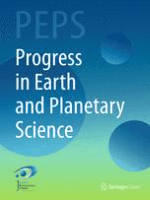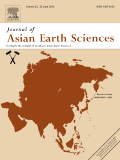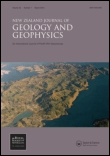
Solid Earth
Scope & Guideline
Unveiling the Secrets Beneath Our Feet
Introduction
Aims and Scopes
- Geodynamics and Tectonics:
Research related to the dynamics of the Earth's crust and mantle, including studies on tectonic plate movements, rifting, and subduction processes. - Volcanology and Petrology:
Exploration of volcanic activity, magma formation, and the chemical and physical properties of igneous rocks, including the study of eruption dynamics and magma evolution. - Seismology and Earthquake Research:
Investigation of seismic activity, earthquake mechanisms, and the assessment of seismic hazards, utilizing both observational data and numerical modeling techniques. - Geophysical Imaging and Modeling:
Utilization of advanced imaging techniques and numerical models to understand subsurface structures and processes, including gravity, seismic, and electromagnetic methods. - Natural Hazards and Risk Assessment:
Studies focusing on natural hazard events such as earthquakes, landslides, and volcanic eruptions, including risk assessment and mitigation strategies. - Environmental Geosciences:
Research addressing the interactions between geological processes and the environment, including the impacts of anthropogenic activities on geological systems.
Trending and Emerging
- Remote Sensing and Drone Technology:
The use of drones and remote sensing technologies for geological mapping and monitoring has gained traction, showcasing advancements in data collection and analysis for geological studies. - Machine Learning and Data Science Applications:
An increasing number of studies are incorporating machine learning algorithms and data science techniques for seismic data interpretation, geological modeling, and anomaly detection. - Hydrogeology and Geothermal Energy:
Research focusing on groundwater systems and geothermal energy extraction has become more prominent, reflecting growing interest in sustainable energy sources and resource management. - Interdisciplinary Approaches to Earth Sciences:
There is a noticeable trend towards interdisciplinary studies that combine geophysics, geology, and environmental science, indicating a holistic approach to understanding Earth processes. - Natural Resource Management and Sustainability:
Themes related to the sustainable management of natural resources, including mineral exploration and environmental impacts, are increasingly relevant, aligning research with societal needs.
Declining or Waning
- Sedimentary Geology:
Research on sedimentary processes, basin evolution, and sedimentary rock studies has decreased, possibly indicating a trend towards more dynamic processes in solid Earth studies. - Geochemical Exploration Techniques:
There appears to be a waning interest in traditional geochemical exploration methods, with fewer publications focusing solely on geochemical analysis compared to integrated approaches with geophysical data. - Paleoclimatology and Paleoenvironments:
Studies related to ancient climates and environments have become less prominent in the journal, possibly overshadowed by more immediate geological processes and their implications.
Similar Journals

DOKLADY EARTH SCIENCES
Bridging Gaps in Earth Science UnderstandingDOKLADY EARTH SCIENCES is a reputable journal published by MAIK NAUKA/INTERPERIODICA/SPRINGER, focusing on the dynamic field of Earth and Planetary Sciences. With an ISSN of 1028-334X and E-ISSN 1531-8354, this journal offers a platform for researchers to disseminate their findings and insights that contribute to our understanding of Earth systems over a continuous publishing span from 1998 to 2024. It currently holds a Q3 quartile ranking in the Earth and Planetary Sciences category, reflecting an emerging yet significant impact within its field, evidenced by its Scopus ranks where it stands at 123rd in general Earth sciences and 113th in miscellaneous Earth sciences. DOKLADY EARTH SCIENCES aims to bridge research gaps and foster collaboration among a diverse audience including researchers, professionals, and students committed to advancing knowledge in geoscience. The journal stands as a vital resource for those seeking to explore contemporary challenges and innovations within the realm of Earth sciences.

Journal of Volcanology and Seismology
Connecting Research to Real-World ApplicationsThe Journal of Volcanology and Seismology, published by PLEIADES PUBLISHING INC, serves as a pivotal platform for disseminating innovative research in the fields of volcanology and seismology. With an ISSN of 0742-0463 and an E-ISSN of 1819-7108, this journal aims to contribute to the understanding of geological processes, providing insights that are essential for both academic inquiry and practical applications in hazard management and environmental conservation. The journal spans from 2007 to 2024 and holds a respectable position in the academic community, classified within the Q3 quartile across key categories including Geochemistry and Petrology, Geology, and Geophysics. Despite the absence of an open access model, the journal remains highly relevant, ranking in the 34th Percentile for Geology and the 33rd Percentile for Geophysics, reflecting its commitment to quality and rigor. Researchers, professionals, and students are encouraged to engage with this resource to enhance their understanding and contribute original findings to the ever-evolving disciplines of Earth sciences.

Progress in Earth and Planetary Science
Catalyzing global discourse in Earth and planetary studies.Progress in Earth and Planetary Science is a premier open-access journal published by Springer, dedicated to advancing the field of Earth and planetary sciences. Since its inception in 2014, this journal has emerged as a prominent platform, achieving a Q1 ranking in the Earth and Planetary Sciences category, reflecting its high impact and rigorous peer-review process that ensures the highest quality of published research. With its broad scope encompassing diverse subfields within the Earth sciences, the journal aims to foster interdisciplinary collaboration and innovation among researchers, professionals, and students. The journal's commitment to accessibility through its open access model promotes the dissemination of knowledge globally, allowing critical research findings to be shared widely within the scientific community. Located in the United Kingdom, Progress in Earth and Planetary Science continues to play an essential role in shaping the future of Earth and planetary research from 2014 to 2024 and beyond.

JOURNAL OF ASIAN EARTH SCIENCES
Connecting Scholars to Asia's Geological LegacyJOURNAL OF ASIAN EARTH SCIENCES, published by Pergamon-Elsevier Science Ltd, is a premier international journal dedicated to advancing the understanding of Earth Sciences, particularly within the vibrant and diverse geological landscapes of Asia. With an esteemed Impact Factor reflective of its robust scholarship, the journal is currently categorized in the Q1 quartile for both Earth-Surface Processes and Geology, highlighting its significant contribution to these fields. Researchers can access cutting-edge research spanning geophysical studies, geological formations, and environmental changes via the journal’s Open Access model, ensuring a broad dissemination of knowledge. As the journal converges its focus from 1997 to 2024, it continues to serve as a critical platform for scholars, professionals, and students aiming to explore the unique challenges and opportunities present in Asian Earth sciences. Its commendable rankings of 28th out of 179 in Earth-Surface Processes and 52nd out of 321 in Geology, demonstrate its influence and relevance in the academic community.

NEW ZEALAND JOURNAL OF GEOLOGY AND GEOPHYSICS
Deepening Understanding of Earth's Dynamic Systems.NEW ZEALAND JOURNAL OF GEOLOGY AND GEOPHYSICS, published by Taylor & Francis Ltd, stands as a prominent forum dedicated to the interdisciplinary exploration of geological and geophysical phenomena. With an impact factor that situates this journal in the prestigious Q1 category across key subjects—namely Earth and Planetary Sciences, Geology, and Geophysics—it is a critical resource for researchers, professionals, and students alike. The journal has been operational since 1958 and continues to contribute valuable insights into the complexities of the Earth's processes. Although it does not currently offer Open Access options, its broad readership benefits from an extensive archive of high-quality research findings that span from 1958 to 2024. Located in the United Kingdom, the journal remains a pivotal player in advancing the understanding of Earth's systems, making significant contributions to both academic inquiry and practical applications in the field.

IZVESTIYA-PHYSICS OF THE SOLID EARTH
Decoding the Dynamics of the Solid EarthIZVESTIYA-PHYSICS OF THE SOLID EARTH, published by MAIK NAUKA/INTERPERIODICA/SPRINGER, serves as a pivotal platform in the field of Earth and Planetary Sciences as well as Environmental Science. With an ISSN of 1069-3513 and E-ISSN 1555-6506, the journal has been disseminating influential research since its inception in 1996, and continues to extend its contributions through 2024. Currently ranked in the Q3 category for both Earth and Planetary Sciences and Environmental Science, it showcases innovative studies that are crucial for understanding geological processes and their environmental implications. Located at 233 Spring St, New York, NY 10013-1578, the journal appeals to researchers, professionals, and students by providing insights and advancements that are at the forefront of these significant scientific disciplines. Although not open access, its rigorous peer-reviewed articles are essential reads for those aiming to deepen their knowledge and stay abreast of current trends and research in solid Earth physics.

China Geology
Bridging Gaps in Earth Science KnowledgeChina Geology, published by KEAI PUBLISHING LTD, is a leading open-access journal that serves as a pivotal platform for disseminating high-quality research across a wide spectrum of Earth sciences. Since its inception in 2018, the journal has rapidly established itself with an impressive Q1 ranking in multiple critical categories, including Geology, Economic Geology, and Oceanography, among others, reflecting its significant contribution to the academic community. Positioned as a top-tier journal in the Earth Planetary Sciences domain, it ranks #22 out of 321 in Geology and exhibits an admirable impact in sub-fields such as Earth-Surface Processes and Geochemistry and Petrology. China Geology is committed to promoting rigorous scientific inquiry and facilitating the open exchange of knowledge in the geosciences, making it an essential resource for researchers, professionals, and students eager to explore innovative developments and fundamental advances in geology. The journal’s accessibility ensures that critical findings reach a broad audience, thereby enhancing collaboration and driving forward scientific discourse in the global community.

ACTA GEOLOGICA SINICA-ENGLISH EDITION
Pioneering Discoveries in Geology and BeyondACTA GEOLOGICA SINICA-ENGLISH EDITION is a distinguished academic journal published by Wiley, providing a platform for cutting-edge research in the field of geology. With an ISSN of 1000-9515 and E-ISSN 1755-6724, this journal has been a pivotal resource since its inception in 1988, catering to scholars and professionals until 2024. The journal is recognized for its high-quality articles, achieving a Q2 ranking in the field of Geology according to the 2023 category quartiles, and ranks #122 out of 321 in the Scopus Earth and Planetary Sciences sector, placing it within the 62nd percentile among its peers. Although currently not available as an open access publication, it remains a significant repository of knowledge that supports ongoing geological research and exploration. For researchers, students, and professionals looking to deepen their understanding of geological sciences, ACTA GEOLOGICA SINICA-ENGLISH EDITION stands as an essential journal, promoting collaboration and innovation in the earth sciences.

GEOTECTONICS
Unveiling the Dynamics of Our Planet's Tectonic Systems.GEOTECTONICS is a distinguished academic journal published by PLEIADES PUBLISHING INC, focusing on key developments in the field of geology. Established in 1978, the journal has dedicated itself to exploring the intricate processes and phenomena associated with Earth's tectonic systems, making substantial contributions to Earth and Planetary Sciences. With an impressive impact factor reflected in its Q2 ranking within the Scopus category of Geology, GEOTECTONICS stands out as a valuable resource for researchers, professionals, and students alike. The journal offers a platform for rigorous peer-reviewed research that spans both fundamental theories and practical applications in geosciences, affirming its significance in fostering academic discourse and advancing geological knowledge. Although it currently does not offer open access, the journal's accessible format and continued publication through to 2024 ensures that it remains at the forefront of geoscientific inquiry.

Journal of Earth Science
Exploring the depths of Earth and beyond.Journal of Earth Science, published by the China University of Geosciences, Wuhan, is a leading journal in the field of Earth and Planetary Sciences, recognized for its significant contributions to the understanding of geological processes and environmental challenges. With an impressive Q1 ranking among Earth and Planetary Sciences journals and a strong position at Rank #39/195 in Scopus, this journal not only showcases high-quality research but also serves as a crucial platform for disseminating innovative findings, spanning a broad spectrum of topics from geophysics to climate change. The journal adopts an open access model, which enhances the visibility and accessibility of research articles published from 2009 to 2024, thereby facilitating collaboration and knowledge sharing among the global scientific community. With its commitment to advancing geosciences, Journal of Earth Science is invaluable for researchers, professionals, and students alike, eager to stay informed and contribute to ongoing discussions in this dynamic field.